

Test your geography knowledge - World continents and oceans. EARTH'S Oceans - Zoom Astronomy. Zoom AstronomyEARTH'S OCEANS Oceans cover about 70% of the Earth's surface.
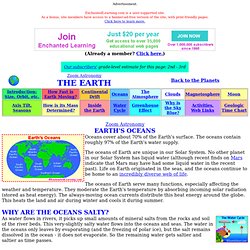
The oceans contain roughly 97% of the Earth's water supply. The oceans of Earth are unique in our Solar System. No other planet in our Solar System has liquid water (although recent finds on Mars indicate that Mars may have had some liquid water in the recent past). Life on Earth originated in the seas, and the oceans continue to be home to an incredibly diverse web of life. The oceans of Earth serve many functions, especially affecting the weather and temperature. As water flows in rivers, it picks up small amounts of mineral salts from the rocks and soil of the river beds. SALINITY The salinity (salt content) of ocean water varies. The oceans are about 3.5% salt (by weight). The saltiest water is in the Red Sea and in the Persian Gulf, which have a salinity of about 40 o/oo (due to very high evaporation rates and low fresh water influx).
Earth's Oceans. Advertisement.
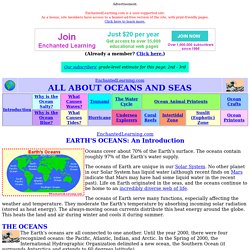
EnchantedLearning.com is a user-supported site. As a bonus, site members have access to a banner-ad-free version of the site, with print-friendly pages.Click here to learn more. (Already a member? Click here.) EnchantedLearning.comEARTH'S OCEANS: An Introduction Oceans cover about 70% of the Earth's surface. The oceans of Earth are unique in our Solar System. The oceans of Earth serve many functions, especially affecting the weather and temperature.
The Earth's oceans are all connected to one another. There are also many seas (smaller branches of an ocean); seas are often partly enclosed by land. WEB LINKS ABOUT OCEAN LIFE, OCEANS AND WATER ON EARTHOcean Animal Printouts from Enchanted Learning. By Jeananda Col Enchanted Learning®Over 35,000 Web PagesSample Pages for Prospective Subscribers, or click below Click to read our Privacy Policy E-mail Copyright ©2000 EnchantedLearning.com ------ How to cite a web page. Ocean Facts for Kids: Atlantic Ocean, Pacific Ocean and Indian Ocean. Interesting Facts for Kids.
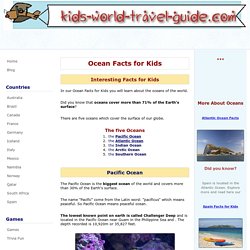
For Educators. More Lesson Plans Find lessons/activities by topic, title or grade levels.
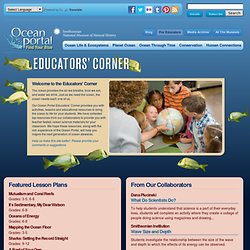
Sort by newest or alphabetically. Lessons were developed by ocean science and education organizations like NOAA, COSEE, and NMEA to help you bring the ocean to your classroom. / WETA/PBS Marine Fisheries and Aquaculture Series Students will study and replicate a model of the factors affecting fisheries populations in the Chesapeake Bay (or any other bay). Grades: 9-12 / NOAA National Marine Sanctuaries Program The goal of this game is to illustrate to the students what happens to a fish stock when large amounts of biomass are removed from a particular species. Grades: 6-8 Through a fishing simulation, students model several consecutive seasons of a commercial fishery and explore how technology, population growth, and sustainable practices impact fish catch and fisheries management.
Grades: 6-8, 9-12 / PBS – Jean Michel Cousteau Ocean Adventures / Marine Stewardship Council Grades: K-2, 3-5. Bridge Ocean Sciences Resources. Media Gallery: Video. Lesson Plan on 7 Continents and 4 Oceans (3rd Grade Geography) Teachers: James Koo & Winston Gonzalez Subjects: Geography & English Grammar Grade: 3rd Grade Length: 50 minutes Geography Lesson Plan Part 1 Topic: Geography - The world Skills Focus: Learning the 7 Continents and 4 Oceans Objectives: SWBAT to identify and name the 7 different Continents, and 4 Oceans.
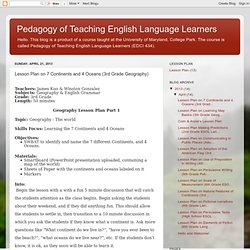
Materials: Smartboard (PowerPoint presentation uploaded, containing a map of the world)Sheets of Paper with the continents and oceans labeled on itMarkers Into: Begin the lesson with a with a fun 5 minute discussion that will catch the students attention as the class begins. Through: After the discussions with the students, ask them for 11 volunteers. Beyond: The students will then be ask to go home and brainstorm about which continents they think they live in. Preposition Lesson Plan Part 2 Topic: English Grammar – Prepositions Skills Focus: Comprehension of Oral Instruction, Writing, Recognizing in Written Context Proficiency: Low to Intermediate.